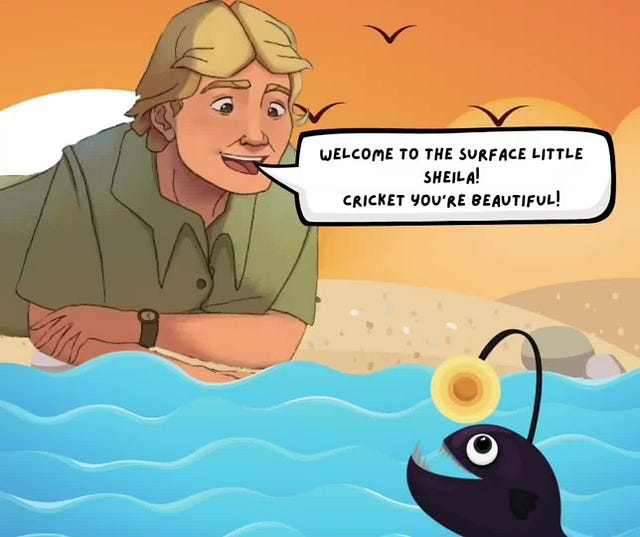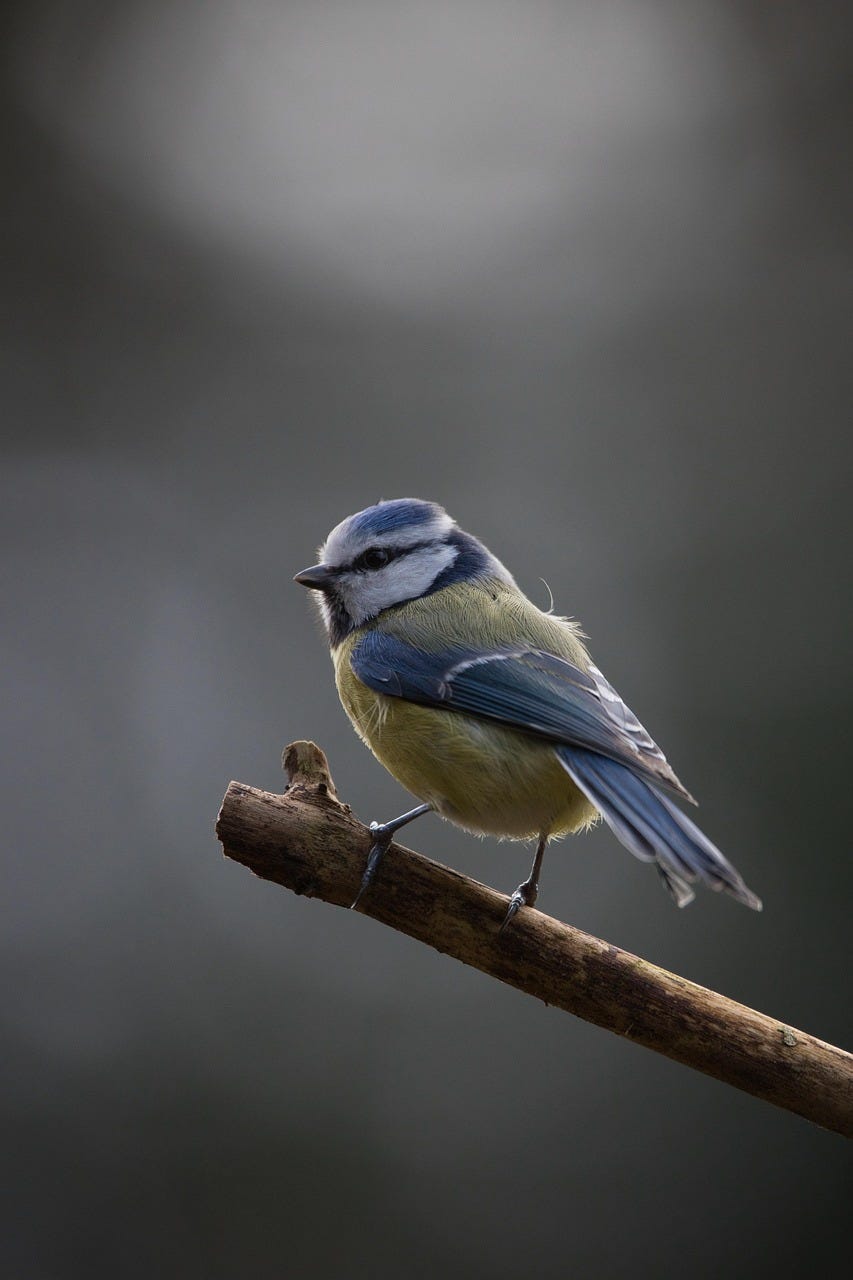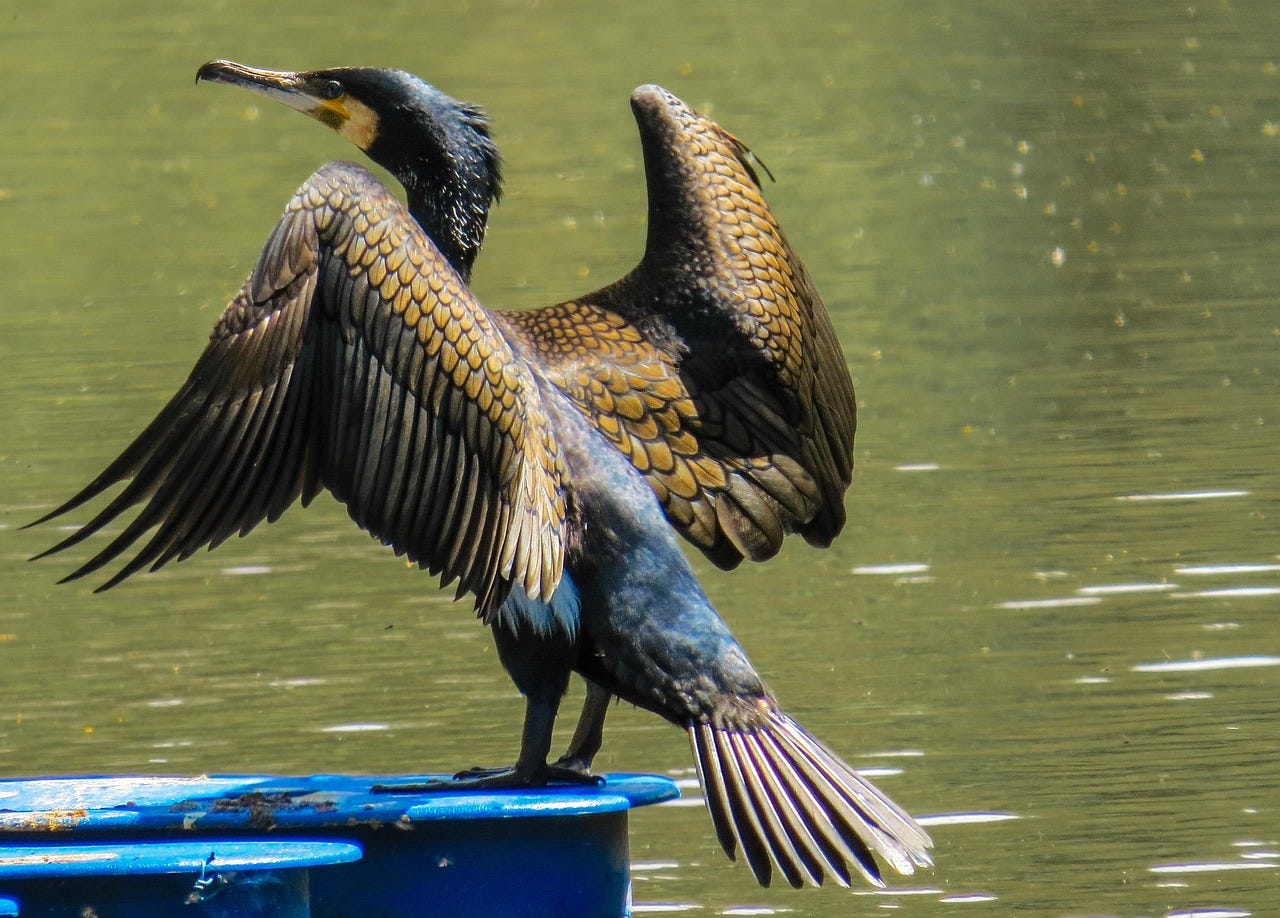The anglerfish, the orca, and the power of empathy
Blurring the lines between science, emotion, and our place in nature.
Welcome back, wild one, my wildling friend. 🌞
It’s always an honor to share this space with you.
I’ve been thinking a lot about the way we see ourselves in nature—how we assign human emotions, struggles, and triumphs to the wild world around us.
“Anthropomorphizing.” Some call it a flaw. I see it as a bridge.
What if it’s exactly what the world needs? Come with me as we blur the lines between facts and feelings, and discover the true value of both.
Feeling Through the Wild
An anglerfish made its way to the surface in Tenerife earlier this month, and the world took notice.
Shortly after her discovery, this tiny, rare traveler from the deep passed away.
Artwork, poetry, and essays flooded the internet, painting a narrative of her final moments: a curious little creature, having lived her entire life in darkness, seeing the sun for the first time.
People imagined that she had witnessed something beautiful even in her last moments. They imagined how she must have marveled at the sight.
There were counterpoints. Scientists reminded us that anglerfish are effectively blind, and that the journey from the depths to the surface was likely painful, not awe-inspiring. That she wasn’t seeing the sunlight—she was dying in it.
Both views hold truth. Facts matter. Understanding the science of the natural world, even when it’s upsetting, is how we take meaningful action to protect it. But emotion matters too. Our instinct is to find meaning.
To feel for this anglerfish is an example of what fuels our desire to care for nature in the first place, and our willingness to take notice of the many mysteries of our oceans. We suddenly remember there's an unexplored landscape out of sight, and mostly out of mind.
Anthropomorphism is often dismissed as a projection of our own feelings, but maybe it’s something deeper: a recognition of connection. A reminder that we are not separate from nature—we are part of its community and its story.
The Orca Who Couldn't Let Go
(Trigger warning: child loss, grief)
In 2018, the world mourned alongside Tahlequah (J35), the southern resident orca who carried her dead calf for 17 days in what became known as her “tour of grief.” In January of this year, she did it again.
Was this anthropomorphism? Or was it something more?
We know orcas are highly intelligent. We know they have complex social structures and deep emotional bonds. They exhibit nurturant behavior, caring for injured or sick pod members, engaging in playful displays of affection, and even grieving their dead.
And yet, the extremity of Tahlequah’s actions went beyond what we could explain.
Through both of her tours, she carried her daughters’ bodies for weeks, depriving herself of essential care. Her family stayed close, even taking turns carrying the burden so J35 could rest.
With each tour, it was as if J35 was telling the world: My daughter was here. She mattered. I loved her.
This is where anthropomorphism and reality blur. We can’t scientifically measure her grief, but does that make it any less real?
What we do know is that her story made international news, sparking deeper awareness about the critically endangered southern resident orcas—of which only 73 remain. Their survival is threatened by overfishing and pollution, with the loss of females like Tahlequah’s daughters making their future even more precarious.
Whether or not we can ever fully understand an orca's mind, one thing is clear: her grief made us care. And when we care, we have a choice to turn that feeling into action. 🐋
Is Anthropomorphizing Really Bad?
Some argue that viewing nature through a human lens distorts facts—that we should strive to see the natural world for what it is, not what we want it to be.
It’s true that anthropomorphizing reflects our emotions more than objective reality.
But I say: Why not both?
If we learn the facts without emotional attachment, we risk losing our sense of connection. If we only feel without understanding, we risk misinterpretation.
However, we can find a balance if we observe, reflect, and apply—the core of the Whispering Wilds O.R.A. process. I teach O.R.A. in depth in the upcoming Whispering Wilds class, but here’s a simple breakdown:
🔎Observe: Notice something in nature without assigning meaning. Use as many of your senses as you safely can.
🔎Reflect: Research what is happening in what you've observed. Seek the facts. Then reflect on what it is about your observation that resonates with you on a personal level.
🔎Apply: Pair your insights with a proven wellness practice and allow the experience to shape you. What can it teach you? How can it inspire change?
When we see ourselves in nature, we cultivate empathy. And empathy is essential for the survival of our world. 🌎
Seeing, Feeling, and Becoming More Like Nature
At the heart of Whispering Wilds is biomimicry—learning from and mimicking nature to improve our lives. 🌿
Biomimicry influences everything from architecture and interior design to medicine, transportation, and how we care for ourselves. Nature has a solution for all our problems.
Curious to explore more? I’ve written about biomimicry’s many wonders on the Whispering Wilds website. Dive in here!
Biophilia, our innate love of the wild, fuels biomimicry. It also sparks the deep, emotional connection that leads us to see ourselves in nature.
We see a tree stretching toward the light, a river carving its path, an orca mother mourning her loss, and we recognize something in them.💙
That recognition is the key to everything.
Be Like a Bird to Wake With Ease
Recently, my 13-year-old son has had some rough mornings.
I wanted to help him start his day with calm and regulation, so he and I turned to something I talked about in last week's newsletter: vagus nerve stimulation.
On the fly (pun intended!) I created a biomimicry-based movement routine inspired by birds. 🦅Using the Whispering Wilds method, we incorporated orienting, rousing, swaying, and stretching to activate our parasympathetic nervous system and squash jitters about the day ahead.
I’d love to share this simple practice with you.
You can do this standing or sitting at your desk or anywhere you feel comfortable. Standing or sitting away from furniture gives you the most space to move freely.
Note: As with all wellness practices, please only do what's medically safe for you. If movement, particularly in your neck, eyes, shoulders, and arms, is painful or dizzying, skip this. There will be other ideas in future posts that may be a better fit! When in doubt, ask your doctor for advice.
Imagine your favorite bird. Any flighted bird!
For me, it's crows. 🐦⬛I have such a close bond with the motley bunch of American crows, common ravens, and the lone fish crow that all form an unlikely but loving nuclear family with me here on our property.
Almost every flighted bird exhibits the behaviors we're about to mimic, so think about a bird that brings you joy.
Step 1: Orienting
Orienting is the instinctive behavior wild animals use to rapidly move their heads and shift their gaze in multiple directions to assess their surroundings for potential threats.
Orienting activates our vagus nerve, which runs up both sides of the neck. It also serves the same purpose as it does for our wild friends: to remind us we're safe.
Look straight ahead. Then move your head and neck side to side, up and down in all directions. Stop briefly and look before moving again. What do you see when you look to the left? How about the right? What about the right corner of the floor? What about the left corner of the ceiling?
Do you see danger? No? Then relax. You're safe. And your vagus nerve is already warming up.
(Don't move so fast that you get dizzy, and always keep your motions gentle.)
I told my son to pretend he was an early bird looking for a worm. He even spontaneously chirped like a robin, caught up in the moment.
Credit where due: I learned the basis of this amazing orienting technique from Dr. Kim De'Re in her Neurotoned program. ✨ I use it every day, applying my unique Whispering Wilds biomimetic twist.
Step 2: Rousing
Rousing is the full-body shake birds do when they feel safe and calm in a place. It helps them clean off and rearrange their feathers.
Shaking or trembling invites us to acceptance and calm. It also allows us to release excess energy.
You may want to start by shaking your hands, as if flinging excess water off your fingers. If you feel comfortable progressing, shake your entire body quickly and briefly, head to toe.
Do this 3 times or more, and notice how your body feels after finishing.
If you fondly remember Raffi's famous children's song, "Shake My Sillies Out," this step may bring you joy!
Step 3: Swaying
Now picture yourself as a bird perched on a branch in a steady breeze. Birds usually stay strong and still on a swaying branch, but their bodies are in a state of motion.
Sway your upper body side to side in the imaginary breeze. Let your body lead you. Enjoy the movement. You can keep the pattern predictable or switch it up by changing directions or incorporating forward and backward motions.
Like a bird, the lower half of your body is firmly planted and secure. You're safe as you allow your upper body to flow with the wind sweeping through your imagination.
Swaying also activates your vagus nerve. If you missed the guided somatic meditation I included in last week's newsletter, I invite you to listen and sway like a willow for calm.
Step 4: Stretching
In this final step, we will spread our wings and stretch like a bird bathing in the sun's warmth.
Raise your arms to shoulder height on either side and angle them slightly backwards as you lift your chin and gently press your chest forward.
Everything about this stretch must be very delicate. Listen to your body. Stop if you experience discomfort.
Repeat this stretch three times.
🦉Feel your chest expand and your heart chakra open.
🦉Feel your neck lengthen. (Most of us spend too many hours hunched over our computers or looking down at our phones.)
🦉Feel the graceful expanse of your arms that do so much work for you.
Now return to center, regulated and rejuvenated.
You've just toned your vagus nerve. The more you practice techniques like this, the better it will support you in handling stress and restoring balance throughout your day. 🍃
If anxiety erodes your calm, you can always be like a bird again any time!
Reflect With Me
Have you ever seen yourself in nature?
Has a poem, film, or piece of art ever moved you through anthropomorphism? I’d love to hear what spoke to you.
Paid subscribers can hit reply, or free subscribers can email me at dina@whisperingwilds.com. Everyone is welcome to share!
Let’s learn, connect, and feel things unashamedly together. 💙
A Parting Note
The Whispering Wilds website has a fresh new look—I’d love you to see it!
Self-paced online classes are coming soon. In the meantime, feel free to browse my live sessions and botanical photography, which inspired the Whispering Wilds method. WhisperingWilds.com
Thank you for being here. For reading, for wondering, for walking this path alongside me.
Your time is a gift, and I cherish it.
Until next time, stay curious, stay connected, and listen for the whispers of the wild. 🌿
Dina
If you enjoy The Whispering Wilds and feel moved to help, tips are always appreciated and keep this space thriving. ✨
Want to share this publication with others?
Please Note...
The Whispering Wilds method is not a replacement for medical and mental health care. Alternative health and wellness shines when it complements modern medicine, just as I believe modern medicine is at its best when accompanied by a holistic perspective. If you have a heart, lung, or circulatory condition, or suspect you do, or if you have a mental health disorder, or suspect you do, please ask your doctor or therapist before beginning any wellness practice.
Breathwork, meditation, journaling, movement, and other practices in The Whispering Wilds aren't suitable for everyone. The good news is that if your doctor or therapist advises you against a particular practice, the Whispering Wilds method will likely present alternatives to explore. Always ask your medical or mental health professionals first because we are all complex, unique individuals, and no true wellness approach is one-size-fits-all.










